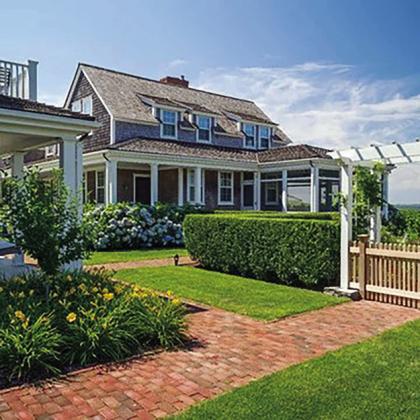Winter can be a true test of the strength of a landscape design. With most of the landscape plants resting during the winter months, things of interest may be scarce. A key element in landscape design to sustain it year-round is the hardscape – those nonliving materials often used to establish the framework and backbone of the garden. A good hardscape will be pleasing, functional and provide interest during the winter months when many plants are dormant.
Hardscape materials include rock, pavers, concrete, wood, etc. These materials are used to create pathways, walls, fences, borders, benches, arbors, sculptures, and other structures. Using hardscape materials that are naturally found in your area, such as native stone, will help tie it into the natural surroundings. Using materials that are complementary to the materials used to build the home helps tie the home and landscape together. The landscape then becomes an extension of the home as well.
Many plants also provide interest during winter months. Evergreen trees and shrubs hold their leaves and colors year-round and contribute form, texture, and mass to the garden. Some deciduous trees and shrubs have interesting or colorful bark that can be seen easier and be more appreciated after the leaves have fallen. Plants with interesting bark include contorted filbert, red-twig dogwood, Japanese kerria, river birch, seven-sonflower, and oakleaf hydrangeas.
There are also several species that produce colorful or interesting fruits that persist into the winter months and may provide food for wildlife as a bonus. Plants that provide winter fruits include evergreen and deciduous hollies, coralberry, roses, firethorn, and Mexican buckeye.
There are even a few plants that produce flowers in winter or late winter/early spring. Witch hazels produce small flowers in January/February. Late winter/early spring bloomers include winter jasmine, winter honeysuckle, cornelian cherry dogwood, redbud, flowering quince, forsythia, and hellebores.
Herbaceous perennials may contribute to the winter landscape as well with their dried seed heads and interesting forms and shapes. Ornamental grasses are particularly attractive as they take on neutral colors and sway back and forth in the breeze.
As we move into the winter months, it is a good time to evaluate the landscape and identify its strengths and weaknesses. It is also an excellent time to work on the hardscape features of the garden. Need some inspiration? There are several excellent web sites, books, and magazines full of creative design ideas. These books and magazines make great gifts for the avid gardener in the family too.

